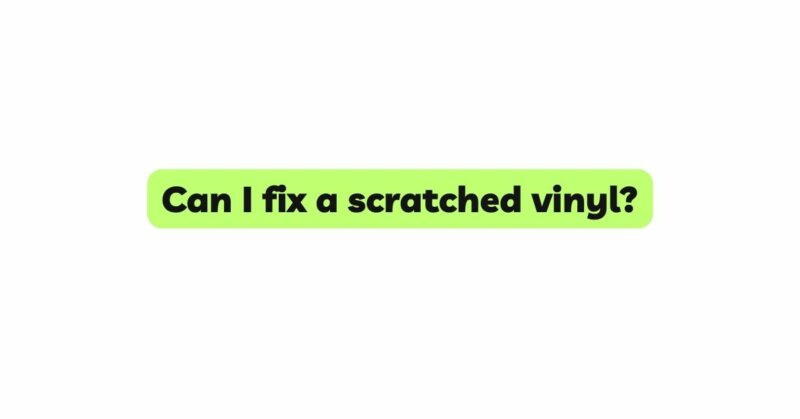Vinyl records have a unique charm that continues to captivate music enthusiasts worldwide. The warm, analog sound and tangible connection to music history make vinyl a cherished medium for many audiophiles. However, these delicate discs are not immune to damage, and scratches are a common occurrence that can mar the listening experience. If you find yourself with a scratched vinyl, fear not! In this comprehensive guide, we will explore the various methods, techniques, and tools available to fix scratched vinyl records and restore them to their former glory.
- Understanding the Anatomy of a Vinyl Record
Before delving into repair methods, it’s essential to understand the basic anatomy of a vinyl record. Vinyl records are circular discs with spiral grooves etched onto their surfaces. These grooves contain the audio information that the stylus (needle) reads to produce sound. Scratches occur when the stylus encounters irregularities in the grooves, resulting in pops, clicks, and distortion during playback.
- Assessing the Severity of the Scratches
The first step in attempting to fix a scratched vinyl is to assess the severity of the damage. Not all scratches are created equal, and some may be less problematic than others. Inspect the vinyl under good lighting and use a magnifying glass if necessary to examine the scratches closely. Take note of their depth, length, and whether they cross the grooves or run parallel to them.
- Cleaning the Record
Before attempting any repairs, it’s crucial to clean the vinyl record thoroughly. Dust, dirt, and debris can exacerbate the effects of scratches and compromise sound quality. Here’s a simple cleaning process:
a. Use a record brush or carbon fiber brush to gently remove loose surface dust.
b. Invest in a record cleaning machine or use a manual cleaning method with a soft microfiber cloth and a record cleaning solution to remove deeper dirt and grime.
- Basic Scratch Repair Techniques
For minor surface scratches or hairline marks, several basic repair techniques can be effective:
a. The Magic Eraser Method: This popular method involves using a white, non-abrasive magic eraser to gently buff out surface scratches. Dampen the eraser slightly, and with a light touch, follow the grooves’ direction. Be cautious not to apply excessive pressure, as it may create more damage.
b. Toothpaste Method: Applying a small amount of non-gel toothpaste to the scratched area and gently rubbing it in a circular motion with a soft cloth or cotton swab can help reduce the visibility of superficial scratches.
c. Pencil Eraser Technique: A soft, white pencil eraser can be used to carefully rub over minor surface scratches. Again, avoid exerting too much pressure to prevent additional harm.
- Specialized Repair Kits
Various vinyl record repair kits are available in the market, each catering to specific types of scratches. These kits often include a variety of tools such as a stylus brush, cleaning solution, and specialized compounds to address different levels of damage. Follow the instructions provided with the kit carefully, and proceed with caution to avoid any unintended consequences.
- Professional Cleaning and Restoration Services
For valuable or severely scratched records, it is advisable to seek the expertise of professional cleaning and restoration services. These specialists possess advanced equipment and techniques to tackle challenging vinyl issues, such as wet cleaning machines, vacuum-based cleaning, and stylus repair tools. Entrusting your cherished records to professionals can often yield excellent results without risking further damage.
- Filling Deep Scratches
In cases of deep scratches that have rendered a groove unreadable, it is possible to fill the scratch to improve sound quality:
a. Vinyl Fillers: Specialized vinyl repair kits include a vinyl filler compound that can be used to fill deep scratches gently. Apply the filler with a steady hand, following the groove’s direction, and allow it to dry thoroughly before playback.
b. DIY Alternatives: Some vinyl enthusiasts have experimented with DIY scratch-filling methods, such as using wood glue or clear nail polish. However, exercise extreme caution with these approaches, as improper application can permanently damage the record.
- Preventive Measures for Maintaining Vinyl Records
Prevention is always better than cure, and adopting proper care and handling practices can minimize the likelihood of scratches and extend the life of your vinyl records:
a. Store Vertically: Store vinyl records upright to prevent damage caused by stacking or sliding.
b. Use High-Quality Sleeves: Replace original paper or thin inner sleeves with anti-static, polyethylene, or polypropylene sleeves to offer better protection against scratches.
c. Handle Records with Care: Always handle records by their edges and avoid touching the playing surface to prevent the transfer of oils and debris.
Conclusion
Scratched vinyl records need not spell the end of your cherished music collection. Armed with the knowledge and techniques explored in this comprehensive guide, you can take the necessary steps to restore your scratched records and enjoy their delightful sounds once more. From basic scratch repair methods and specialized kits to professional cleaning and restoration services, the options available to you are diverse. However, always approach repairs with caution and remember that valuable or sentimental records may be best entrusted to the hands of professionals. By practicing proper care and handling, you can prevent future scratches and ensure your vinyl collection remains a source of joy for years to come.


